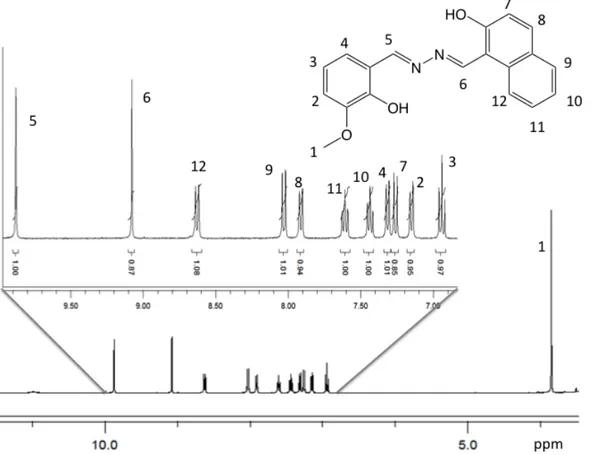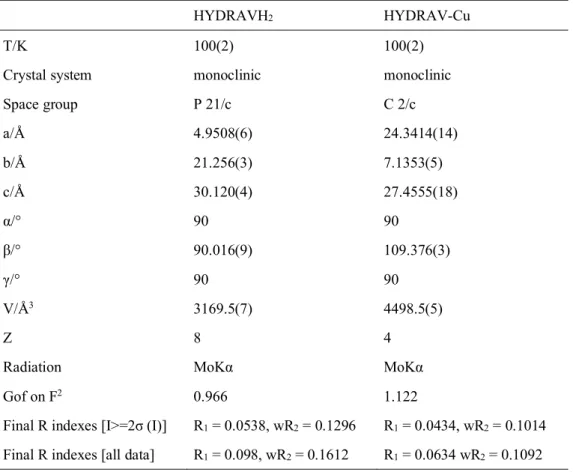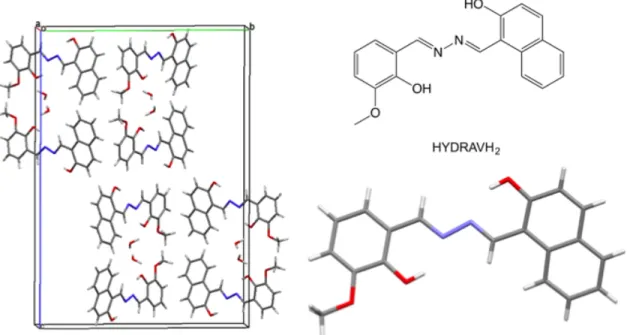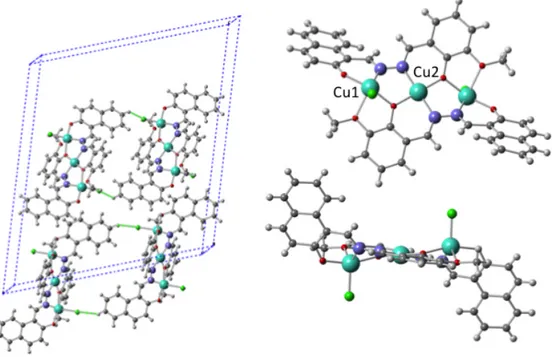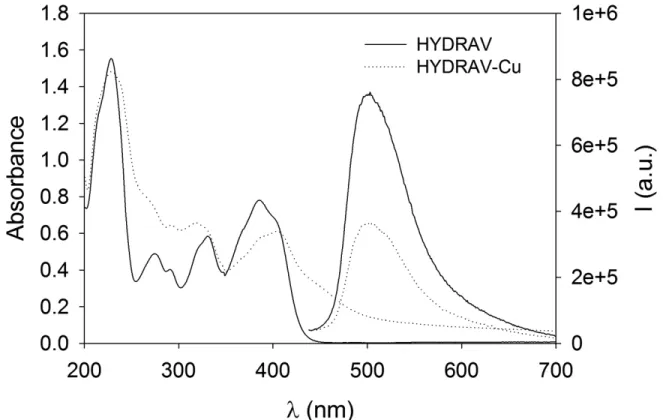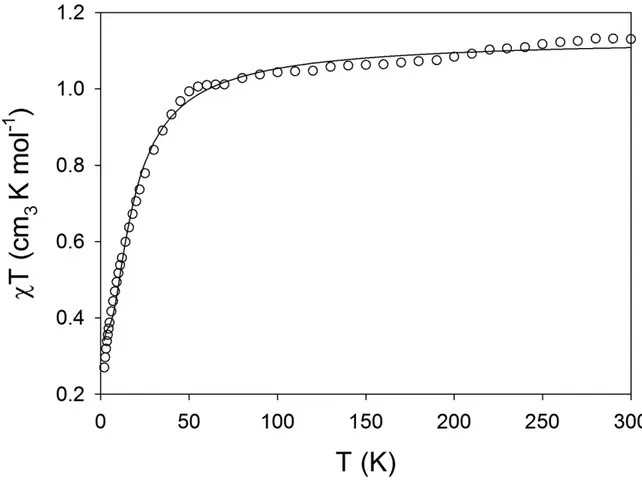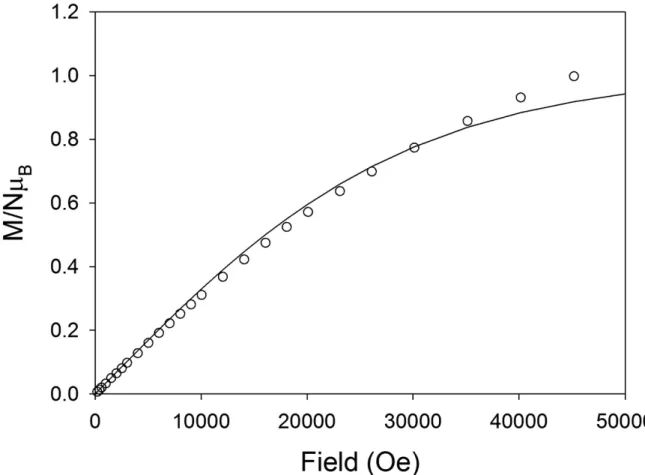A new trinuclear N-N bridged Cu(II) complex with an asymmetric Schiff base
ligand derived from hydrazine
Samira Gholizadeh Dogaheh,b Hamid Khanmohammadi,b E. Carolina Sañudoa,c*
a Departament de Química Inorgànica i Orgànica, Secció de Química Inorgànica, Universitat de Barcelona. Av. Diagonal 645, 08028 Barcelona, Spain
b Department of Chemistry, Faculty of Science, Arak University, Arak 38156-8-8349, I. R. Iran
c Institut de Nanociència i Nanotecnologia (IN2UB), Universitat de Barcelona, Barcelona, Spain
Published in Polyhedron 133 (2017) 48–53 Abstract
In this paper we report the synthesis of an asymmetric Schiff base ligand derived from hydrazine and its Cu(II) trinuclear coordination complex, [Cu3(HYDRAV)2Cl2] (HYDRAV-Cu). The ligand HYDRAVH2 and the Cu(II) complex HYDRAV-Cu have been crystallographically characterized. HYDRAVH2 contains a fluorescent naphtyl group and emission properties of both HYDRAVH2 and HYDRAV-Cu are reported. The magnetic properties of HYDRAV-Cu have been investigated. Hydrazine is an excellent precursor for asymmetric Schiff base ligands that afford antiferromagnetic coupling as shown here for HYDRAV-Cu.
Introduction
Polyfunctional Schiff bases are very useful ligands in the synthesis of transition metal complexes. Symmetric and asymmetric Schiff base ligands can provide suitable donor sets capable of holding three metal ions in a linear complex. In particular, an asymmetry in the donor groups of the ligand can be exploited to obtain heterometallic linear complexes with some control over the position of the metals.1 Schiff bases are prepared by condensation of an aldehyde or ketone and an amine. This simple reaction can be exploited with di-amines to obtain multiple coordination pockets in one ligand. Furthermore, the organic groups that form the aldehyde and amine can be varied practically at one's will to provide further
functionality to the final ligand. Most often in coordination chemistry the aldehyde is salicyladehyde. The use of salicyladehyde and ethylendiamine leads to the well-known symmetric salen type ligands that have been extensively studied due to the wide variety of metal complexes that can be obtained by carefully tuning the substituents of the two components of the Schiff base. The versatility of these ligands that can be coordinated to transition metals or lanthanides makes them very widely used to obtain coordination complexes with applications in materials science,2 magnetic materials3–5 or catalysis6. In our group we are interested in complexes with interesting magnetic properties. In this area Schiff base ligands have been widely used, a search with keywords 'Schiff base' and 'magnetic properties' will yields hundreds of results. We have used Schiff base ligands in the past to obtain building blocks for MOFs,7 or multifunctional complexes,8,9 taking advantage of the multiple possibilities Schiff base ligands offer. In particular we used diaminoacridine and acridine yellow as di-amines to obtain symmetric, fluorescent Schiff base ligands that afforded fluorescent ferromagnetically coupled complexes. The use of hydrazine to provide the nitrogen atoms of the Schiff base is not very common, but it is possible to perform a two-step reaction where two different aldehydes can be used to obtain an asymmetric Schiff base ligand.10 By using hydrazine as the source of the nitrogen atoms of the Schiff base one obtains ligands that have NN moieties. In the literature there are many reports of such ligands, where the NN groups is part of a pyrazole or triazole11–15 and pyridazine16 group. These type of ligands are important in magnetism and in particular in Cu(II) magnetic complexes, since they usually afford a good exchange pathway for antiferromagnetic coupling.17–21 Copper complexes can be used as models to test magnetic exchange on more complicated systems.
In the present study, we report the synthesis and characterization of the new fluorescent, asymmetric Schiff base ligand derived from hydrazine HYDRAVH2 and its fluorescent Cu(II) complex HYDRAV-Cu, of formula [Cu3HYDRAV2Cl2]. The magnetic properties of HYDRAV-Cu are compared with similar complexes reported in the literature.
Experimental
All chemicals were purchased from commercial sources and used as received. Synthesis of ligand (HYDRAVH2)
The ligand 1-(hydrazineylidenemethyl)naphthalen-2-ol was synthesized from hydrazine and 2-hydroxy-1-naphthaldehyde according to a literature method.10 2-hydroxy-1-naphtlaldehyde (1.74 g, 10.2 mmol) in methanol was added dropwise for an hour to hydrazine hydrate (98 %) (2.58 g, 50.6 mmol) at room temperature. A yellow precipitate formed and was collected by filtration and washed with ether. Yield 60%.
0.456 g (2.99 mmol) of 2-hydroxy-3-methoxybenzaldehyde were added slowly to a solution of 1-(hydrazineylidenemethyl)naphthalen-2-ol (0.558 g, 2.99 mmol) in methanol (20 ml). The resulting solution was stirred and heated at reflux for 3 h. The precipitated product was filtered and washed three times with methanol and dried with diethyl ether. Yield: 83 % (0.8 g); m.p. 224.5-226˚C. Yellow needle crystals suitable for single-crystal X-ray diffraction were grown from slow evaporation of acetonitrile solution.
1H NMR (DMSO-d6, 300 MHz, ppm): δ 9.88(s,1H), 9.08(s,1H), 8.64 (d, 1H, J = 8.61 Hz), 8.04 (d, 1H, J =9Hz), 7.92(d, 1H, J=7.75Hz),7.63 (t, 1H, J = 8.25 Hz), 7.45 (t, 1H, J=7.17 Hz), 7.33 (d, 1H, J=7.9Hz), 7.27 (d, 1H, J=8.98 Hz), 7.16 (d, 1H, J =8.00Hz), 6.96 (t, 1H, J=7.91Hz), 3.86(s, 3H). Selected IR data (KBr, cm-1): 3439.13(m), 29926.09(m), 2847.83(m), 1608.70 (s), 1543.48 (w), 1456.52 (s), 1386.96 (w), 1313.04(m), 1256.52 (s), 1186.96 (m),1082.61(w), 969.57 (m), 782.61(m), 734.78(s). λmax(nm) (ε (M-1 cm-1)): 231 (76225) , 279 (23390), 335 (28425) and 391 (37700) in THF. ESI-MS: MW(C19H16N2O3) = 320.12, monoisotopic mass = 320, experimental m/z (M+1H+) = 321.12.
Synthesis of Cu-complex (HYDRAV-Cu)
A solution of CuCl2.2H2O (0.319 g, 1.872 mmol) in CH3CN (5 mL) was added to a solution of ligand (0.2 g, 0.624 mmol) and Et3N (260 µL, 3.744 mmol) in CH3CN (15 mL). The mixture was stirred and heated under reflux for 4 h. Afterwards, a precipitate was filtered and washed with hot CH3CN three times and then with diethyl ether. Yield 0.235 g (83 %). Crystals were obtained after a few days from a concentrated acetonitrile solution by slow evaporation and were handpicked since there was also precipitate. Handpicked crystals were used for SQUID, UV-vis and fluorescence.
Selected IR data (KBr, Cm-1): 3043.48(w), 2921.74(w), 2826.09(w), 1600.00 (s), 1534.78 (s), 1452.17 (s), 1430.43 (s), 1386.96 (m), 1356.52 (m), 1243.48 (s), 1217.39(s), 1182.61
(s), 986.96(w), 956.52(w), 830.43(m), 739.13(s). λmax(nm) (ε (M-1 cm-1)): 234 (72750) , 328 (31450) and 411 (29250) in THF.
Experimental methods
Single crystal diffraction data for all the compounds were collected on a Bruker APEXII SMART QUAZAR diffractometer at the GMMF laboratory, Universitat de Barcelona, using a microfocus Molybdenum kα radiation source. The structures were solved by intrinsic phasing (SHELXT) and refined on F2 (SHELXL-97). Hydrogen atoms were included on calculated positions, riding on their carrier atoms. Infra-Red spectra were performed on a Thermo scientific AVATAR 330 FT-IR; Fluorescence measures were taken in a NanoLogTM-Horiba JobinYvon iHR320 spectrophotometer; UV-Vis spectra were acquired in a Cary 100 Scan from Varian. Elemental analyses were carried out at the Analysis Service, CSIC. Mass spectrometry data were collected at the Unitat d'Espectrometria de Masses (CCiTUB). Magnetic measurements on crushed polycrystalline, vacuum dried samples (SQUID magnetometer equipped with a 5T magnet, diamagnetic correction applied using Pascal's constants) were done at the Servei de Mesures Magnètiques of CCiT-UB.1H-NMR (Varian Unity 400 MHz) were performed at the NMR service of CCiT-UB.
Results and discussion
Following our interest in Schiff base ligands,8,22,23 and in particular in asymmetric ligands, we designed and prepared the fluorescent ligand HYDRAVH2 through Schiff base condensation reaction of 1-(hydrazineylidenemethyl)naphthalen-2-ol with o-Vanillin (2-hydroxy-3-methoxybenzaldehyde). The formation of the di-imine ligand followed a two-step procedure. In the first two-step, 2-hydroxy-1-naphtlaldehyde was reacted with hydrazine at room temperature to obtain 1-(hydrazineylidenemethyl)naphthalen-2-ol. Following isolation by filtration, 1-(hydrazineylidenemethyl)naphthalen-2-ol was treated under reflux with o-vanillin, as shown in Scheme 1, to provide the asymmetric ligand HYDRAVH2 in good yield. The obtained ligand HYDRAVH2 can be used without further purification. HYDRAVH2 was characterized by IR, UV-vis, proton NMR as shown in Figure 1, ESI-MS and single crystal X-ray diffraction. The ligand has two clear coordination pockets, with O and N donors, and if the OMe group from vanillin were to take a role in metal coordination, one could envision three coordination pockets. The most stable form of the ligand should
be that with a transoid configuration of the C=N--N=C moiety that forms two H-bonds between the Ar-OH and the imine nitrogen atoms, as shown in Scheme 1. In fact, this is the conformation found in the crystal structure of the ligand.
Scheme 1. Synthesis of HYDRAVH2.
OH
O
NH
2NH
2+
Step 1
R. T.
OH
N
NH
2Step1
Reflux
O
OH
O
O
OH
N
N
HO
HYDRAVH
2Figure 1. Assigned proton NMR of HYDRAVH2 in CD3CN. Solvent area is not shown in the spectra.
Treatment of HYDRAVH2 with CuCl2.2H2O in acetonitrile afforded dark-brown crystals of [Cu3(HYDRAV)2Cl2].4CH3CN, HYDRAV-Cu. In the complex, the ligand coordinates to three Cu(II) ions, with the OMe group of vanilline actively taking part in the coordination. The C=N--N=C moiety that results from using hydrazine to prepare Schiff bases is common in coordination chemistry, and it is not unusual to find it bridging two metals.24–27 However, it is also common to find ligands with two OH ortho with respect to the C=N--N=C group is to chelate one metal with two O and two N donors.28
Description of crystal structures
Table 1 contains the crystallographic data and structural parameters for HYDRAVH2 and HYDRAV-Cu. X-ray crystallographic analysis reveals that HYDRAVH2 crystallizes in the monoclinic space group P21/c and the crystal structure is shown in Figure 2. The asymmetric unit consists of two HYDRAVH2 ligands and two lattice water molecules. The
crystal structure shows the intramolecular hydrogen bond between the oxygen atom of the phenol group and the hydrazine nitrogen, the N-N bond is transoid in the free protonated ligand maximazing the stabilization of these OH--N intramolecular H-bonds. The transoid C=N--N=C arrangement upon coordination of metals like Fe(III) that prefer hexacoordinated environment is often observed and results in helicates.29
Table 1. Crystallographic and data collection parameters for HYDRAVH2 and HYDRAV-Cu
HYDRAVH2 HYDRAV-Cu
T/K 100(2) 100(2)
Crystal system monoclinic monoclinic Space group P 21/c C 2/c a/Å 4.9508(6) 24.3414(14) b/Å 21.256(3) 7.1353(5) c/Å 30.120(4) 27.4555(18) α/° 90 90 β/° 90.016(9) 109.376(3) γ/° 90 90 V/Å3 3169.5(7) 4498.5(5) Z 8 4
Radiation MoKα MoKα
Gof on F2 0.966 1.122
Final R indexes [I>=2σ (I)] R1 = 0.0538, wR2 = 0.1296 R1 = 0.0434, wR2 = 0.1014
Figure 2. Crystal structure and packing of the free ligand HYDRAVH2.
HYDRAV-Cu crystallizes in the monoclinic space group C2/c. The crystal structure and packing diagrams are shown in Figure 3. The asymmetric unit contains one ligand, two Cu(II) ions (Cu1 and Cu2, with half occupancy sitting on a crystallographic inversion centre), one chloride ion and two lattice CH3CN molecules. The Cu1 ion is pentacoordinated in a distorted square pyramidal environment. The coordination sphere of Cu1 is filled by three oxygen atoms from naphtol of one ligand and o-vanillin group of the second ligand, one nitrogen from the imine group of the ligand that provides the naphtol and one chloride. Cu2 is sitting in a crystallographic inversion center and it is tetracoordinated with a distorted square planar geometry, coordinated to one imine nitrogen and one vanilline phenoxo group from both of the two ligands. The Cu1-Cu2 distance is 3.326Å. When the HYDRAVH2 ligand deprotonates and coordinates to three Cu(II) ions, the N-N bond which had a transoid arrangement in the free ligand suffers a rotation and becomes cisoid, with the two C=N bonds at the same side of the bond. There is thus a linear arrangement of O-N-N-O-O donors that bind three Cu(II) ions by the two HYDRAV ligands, in a head-to-tail arrangement with respect to each other.
Cu1 and Cu2 are bridged by a phenoxo from the vanillin group of one of the HYDRAV ligands and by the two N of the imines of the other HYDRAV ligand. The complex has a
planar core, that comprises the three Cu(II) ions and the vanillin groups form both HYDRAV ligands, as shown in Figure 3. From this fairly planar moiety, the chlorides and naphtol groups stick up and down. The most significant intermolecular interaction are CH-p interactions with the lattice solvent and Cl--HC(sCH-p2) (C---Cl distance 3.6 Å, Cl--H distance is 2.6 Å, bonds shown in dashed green in Figure 2) between the chloride of one HYDRAV-Cu molecule and the adjacent HYDRAV-Cu molecule, forming a chain along the a axis of the unit cell. Chloride ions coordinated to metal centers, as those found in HYDRAV-Cu are often found to establish H-bonds with suitable donors, as reported by Aullón and co-workers, the distances found in HYDRAV-Cu are in agreement with the distances reported.30
Figure 3. Crystal structure and packing for HYDRAV-Cu. Cu cyan, C gray, N blue, O red, H light gray, Cl green. CH--Cl bonds are shown in dashed green. Color online.
UV-Vis and fluorescent properties
The photophysical properties of HYDRAVH2 and HYDRAV-Cu were recorded in MeCN solution (2×10-5 M) at room temperature. Electronic spectra from HYDRAV and HYDRAV-Cu are shown in Figure 4. The UV–Vis spectra from the free ligand
HYDRAVH2 showed the typical absorptions at 231 and 280 nm assigned to the π–π* transition of the aromatic rings and azomethine chromophores. The peaks at 336 nm and 391 nm were attributed to n–π* forbidden transition bands from azomethine and phenol groups. HYDRAV-Cu exhibited absorption bands at 234, 328 and 411 nm. There is a clear change in the absorption spectrum upon deprotonation and coordination. The main change is clearly seen in the 350-500 nm region. The broad absorption band around 460 nm can be assigned to formation of HYDRAV-Cu.
Figure 4. Electronic and emission spectra acetonitrile of HYDRAVH2 and its Cu(II) complex HYDRAV-Cu. The excitation wavelength for emission was 380 nm.
The fluorescent properties of HYDRAVH2 and its complex were studied. The fluorescent naphthyl group is the main contributor to the observed emission spectra. As shown in Figure 4, the fluorescence emission of the free HYDRAVH2 ligand appears at around 495 nm with excitation wavelength of 380 nm. The emission spectrum of HYDRAV-Cu showed a quenching of the fluorescence. The coordination of a paramagnetic ion like Cu(II)
is known to provoke a quenching of the fluorescence, as reported by Aliaga et al, among others.31,32
Magnetic Properties
Dc magnetic susceptibility data were collected for the complex HYDRAV-Cu in the 2–300 K temperature range and at applied dc fields of 510 and 10000 Oe. The temperature dependence of the magnetic susceptibility is shown as χMT versus T plot in Figure 5. As temperature decreases, the χMT product is nearly constant until a sharp decrease is observed at 50 K. The χT product at 300 K is in agreement with three isolated Cu(II) ions with S = 1/2 and g = 2.0.
The magnetic data for HYDRAV-Cu was modeled by using PHI.33 PHI is a computer package that uses the phenomenological Hamiltonian Ĥ = Ĥ(crystal field) + Ĥ(Zeeman) – 2JijΣŜiŜj. This system is solved by evaluating the matrix elements of the Hamiltonian over the basis states and diagonalizing the Hamiltonian matrix. The susceptibility data for HYDRAV-Cu were fitted assuming a model in which the central Cu(II) is coupled to the other two Cu(II) ions by an exchange constant J = -7.21 cm-1 and the g factor was equal for all three Cu(II) ions with a value of g = 2.03. The antiferromagnetic exchange constant obtained from fitting the susceptibility data results in an S = 1/2 ground state. These values fit both the susceptibility at various temperatures and the magnetization data at 2 K, the fitting is shown on Figures 5 and 6 as solid lines. The magnetization versus field data collected at 2 K are shown in Figure 6 and it shows the population of an S = 1/2 spin ground state for HYDRAV-Cu.
Figure 5. Magnetic susceptibility data for HYDRAV-Cu. The solid line is the best fit to the experimental data. See text for fitting parameters.
Figure 6. Magnetization as a function of field at 2 K for HYDRAV-Cu. The solid line is the best fit to the experimental data. See text for fitting parameters.
There are a handful of examples in the literature of Cu(II) complexes bridged by two nitrogen atoms and a O-R bridge (R = Me, Ph, H) like in our complex HYDRAV-Cu. The N-N moiety can be part of pyrazole or triazole,11–15 pyridazine16 or hydrazine27, the hydrazine-type ligands being the least common in this Cu-OR/NN-Cu units. The most usual are pyrazolate derivatives. Both pyrazolate and pyridazine lead to strong antiferromagnetic coupling. There are much fewer examples with the NN moiety comes from hydrazine and is part of di-imine ligand as in HYDRAV-Cu. Tang and co-workers reported the Cu-Cu interaction with two such NN bridges as -28.32 cm-1 by fitting the experimental data of a Y2Cu2 complex.24 It is worth to point out that in Tang's Y2Cu2 complex the NN moieties are in the cisoid conformation, as that found in our complex HYDRAV-Cu. The two structural parameters that are relevant for the magnetic coupling are the O-Cu angle and the
Cu-N-N-Cu torsion angle. For complexes with two Cu-NN-Cu bridges from pyrazole Bu and Ribas showed that the geometry of the Cu-NN/NN-Cu moiety was a determinant factor for J: the Cu-NN-Cu torsion angles were all between 0 and 15o and the exchange constants had values as large as -211 cm-1.19 The phenoxo Cu-O-Cu angle is 115o, with this angle the coupling between the two Cu(II) ions should be antiferromagnetic. Magnetostructural correlation for Cu-OR-Cu,34 Cu-OH-Cu,35 and Cu-OPh-Cu36 usually restrict the Cu-O-Cu angles to between 90o and 105o, since these are the angles observed in such complexes: the interaction changes from ferromagnetic to antiferromagnetic around 95o and then it increases linearly with the angle in this range. In complexes with the Cu-OR/NN-Cu units the Cu-O-Cu angles are all similar, around 115o and the Cu-NN-Cu torsion angles are between 5o and 26o. The exchange constant values range from -455 to -68 cm-1. The Cu-O-Cu angle in the Cu-O-Cu-OR/NN-Cu-O-Cu units is directly related to the NN bridge between the two Cu ions and thus it is similar for all the reported complexes with Cu-OR/NN-Cu units. The relationship between J and the Cu-NN-Cu torsion angles for all the reported complexes with Cu-OR/NN-Cu units follows a general trend. The larger the torsion angle, that is, the deviation from planarity of the two imine and Cu ions of the Cu-OR/NN-Cu units, the smaller the coupling. For HYDRAV-Cu the torsion angle is 35.9o. Clearly, for hydrazine derivatives the torsion can be much larger than for pyridazine, pyrazole or triazole derivatives due to the flexible backbone of the ligand, since the NN moiety is not part of a rigid group like an aromatic ring. This affects the orbital overlap and thus, the magnetic coupling. The torsion of the equatorial planes containing the dx2-y2 orbitals are rotated in HYDRAV-Cu, leaving a non-planar orientation that reduces the extent of the orbital overlap. This fact has previously been observed for Cu-OR/OR-Cu complexes.37 Wang and co-workers report the exchange for a single Cu-NN-Cu from pyrazole38 as -12 cm-1 and relate this small value to the fact that the basal plane of each copper atom is nearly parallel to a neighboring pyrazole plane and perpendicular to another neighboring pyrazole plane. This value is similar to the value we report for HYDRAV-Cu and is also in agreement with our observation of the large Cu-NN-Cu torsion. The Cu-NN-Cu torsion angle of HYDRAV-Cu is the largest reported for Cu-OR/NN-Cu units. A complex reported by Wei and coworkers has a hydrazine derived Cu-OR/NN-Cu unit with Cu-NN-Cu angle of 29o, but the authors do not report any magnetic data.27
Summary
The new asymmetric, fluorescent Schiff base ligand HYDRAVH2 has been prepared and characterized. The preparation method is a general one that can be easily extended to other asymmetric ligands, since it is a two-step reaction that is useful to avoid substituents in the two aldehydes that can react or interact to provide undesired products. HYDRAVH2 is a very promising ligand for the preparation of heterometallic complexes, a line that we are already exploring. Hydrazine is thus proved to be a very promissing source for new asymmetric Schiff base complexes that has not been widely exploited. We report here also a homometallic trinuclear Cu(II) complex of HYDRAV-Cu and its magnetic properties, finding that the lack of rigidity characteristic of the NN moiety derived from hydrazine results in antiferromagnetic coupling between Cu(II) ions. This fact could be exploited to tune the magnetic exchange with other metals and heterometallic complexes.
Appendix A. Supplementary data.
CCDC 1513620 and 1513621 contain the supplementary crystallographic data for HYDRAVH2 and HYDRAV-Cu. These data can be obtained free of charge
via http://www.ccdc.cam.ac.uk/conts/retrieving.html, or from the Cambridge Crystallographic Data Centre, 12 Union Road, Cambridge CB2 1EZ, UK; fax: (+44) 1223-336-033; or e-mail: [email protected].
Acknowledgements
ECS acknowledges financial support from the Spanish Government via FEDER Funding (CTQ 2012-32247, CTQ2015-68370-P). SG and HK acknowledge support from Iranian Ministry of Science Research and Technology (MSRT) for funding SG for a stay at GMMF-UB.
References
(1) Vigato, P. A.; Tamburini, S. Coord. Chem. Rev. 2004, 248, 1717–2128. (2) Crane, A. K.; MacLachlan, M. J. Eur. J. Inorg. Chem. 2012, 17–30.
9870–9880.
(4) Chien, Y. L.; Chang, M. W.; Tsai, Y. C.; Lee, G. H.; Sheu, W. S.; Yang, E. C.
Polyhedron 2015, 102, 8–15.
(5) Miyasaka, H.; Saitoh, A.; Abe, S. Coord. Chem. Rev. 2007, 251, 2622–2664. (6) Cozzi, P. G. Chem. Soc. Rev. 2004, 33, 410–421.
(7) Laye, R. H.; Sañudo, E. C. Inorganica Chim. Acta 2009, 362, 2205–2212. (8) Dogaheh, S. G.; Heras Ojea, M. J.; Piquer, L. R.; Artús Suàrez, L.;
Khanmohammadi, H.; Aromí, G.; Sañudo, E. C. Eur. J. Inorg. Chem. 2016, 2016, 3314–3321.
(9) Heras-Ojea, M. J.; Mañeru, D. R.; Rosado, L.; Zuazo, J. R.; Castro, G. R.; Tewary, S.; Rajaraman, G.; Aromí, G.; Jiménez, E.; Sañudo, E. C. Chem. Eur. J. 2014, 20, 10439–10445.
(10) Sousa, C.; Freire, C.; De Castro, B. Molecules 2003, 8, 894–900.
(11) Su, C. Y.; Tong, Y. Z.; Yuan, F. C.; Wang, Q. L.; Ma, Y.; Yang, G. M.; Liao, D. Z.
Inorganica Chim. Acta 2014, 423, 545–549.
(12) Novitchi, G.; Wernsdorfer, W.; Chibotaru, L. F.; Costes, J.-P.; Anson, C. E.; Powell, A. K. Angew. Chem. Int. Ed. Engl. 2009, 48, 1614–1619.
(13) Bai, Y. L.; Tangoulis, V.; Huang, R. Bin; Zheng, L. S.; Tao, J. Chem. - A Eur. J. 2009, 15, 2377–2383.
(14) Mazureck, W.; Kennedy, B. J.; Rodgers, J. R.; Murray, K. S.; O’Connor, M. J.; Rodgers, J. R.; Snow, M. R.; Wedd, A. G.; Zwack, P. R.; Peter, R. Inorg. Chem. 1985, 3258–3264.
(15) Craig, G. A.; Schu, M.; Aguila, D.; Roubeau, O.; Ribas-arin, J.; Vela, S.; Teat, S. J.; Arom, G. Inorg. Chem. 2014, 53, 3290–3297.
(16) Thompson, L. K.; Mandal, S. K.; Gabe, E. J.; Lee, F. L.; Addison, A. W. Inorg.
Chem. 1987, 657–664.
(17) Fustero, S.; Sánchez-Roselló, M.; Barrio, P.; Simón-Fuentes, A. Chem. Rev. 2011,
111, 6984–7034.
(18) Du, M.; Chen, S.-T.; Guo, Y.-M.; Bu, X.-H.; Ribas, J. J. Mol. Struct. 2005, 737, 17– 21.
Chem. 2006, 45, 162–173.
(20) Mohan, M.; Bond, M. R.; Otieno, T.; Carrano, C. J. Inorg. Chem. 1995, 34, 1233– 1242.
(21) Chandrasekhar, V.; Dey, A.; Senapati, T.; Sanudo, E. C. Dalt. Trans. 2012, 41, 799– 803.
(22) Laye, R. H.; Sañudo, E. C. Inorganica Chim. Acta 2009, 362, 2205–2212.
(23) Heras-Ojea, M. J.; Mañeru, D. R.; Rosado, L.; Zuazo, J. R.; Castro, G. R.; Tewary, S.; Rajaraman, G.; Aromí, G.; Jiménez, E.; Sañudo, E. C. Chem. - A Eur. J. 2014,
20, 10439–10445.
(24) Wu, J.; Zhao, L.; Zhang, P.; Zhang, L.; Guo, M.; Tang, J. Dalt. Trans. 2015, 44, 11935–11942.
(25) Zhang, L.; Liu, F.; Yuan, S.; Wang, X.; Sun, D. Acta Crystallogr. Sect. C Cryst.
Struct. Commun. 2012, 68.
(26) Wu, D.; Guo, D.; Song, Y.; Huang, W.; Duan, C.; Meng, Q.; Sato, O.; Wu, D.; Guo, D.; Song, Y.; Huang, W.; Duan, C.; Meng, Q. 2014, 48, 854–860.
(27) Wei, M. L.; Sun, J. J.; Duan, X. Y. Eur. J. Inorg. Chem. 2014, 3, 345–351.
(28) Sutradhar, M.; Martins, L. M. D. R. S.; Guedes Da Silva, M. F. C.; Mahmudov, K. T.; Liu, C. M.; Pombeiro, A. J. L. Eur. J. Inorg. Chem. 2015, 2015, 3959–3969. (29) Mo, H.; Fang, C.-J.; Duan, C.-Y.; Li, Y.-T.; Meng, Q.-J. Dalt. Trans. 2003, 1229–
1234.
(30) Aullón, G.; Bellamy, D.; Orpen, G.; Brammer, L.; Bruton, E. A. Chem. Commun. 1998, 653–654.
(31) Aliaga-Alcalde, N.; Rodríguez, L.; Ferbinteanu, M.; Höfer, P.; Weyhermüller, T.
Inorg. Chem. 2012, 51, 864–873.
(32) Díaz-Torres, R.; Menelaou, M.; Roubeau, O.; Sorrenti, A.; Brandariz-de-Pedro, G.; Sañudo, E. C.; Teat, S. J.; Fraxedas, J.; Ruiz, E.; Aliaga-Alcalde, N. Chem. Sci. 2016, 7, 2793–2803.
(33) Chilton, N. F.; Anderson, R. P.; Turner, L. D.; Soncini, A.; Murray, K. S. J. Comput.
Chem. 2013, 34, 1164–1175.
(34) Merz, B. L.; Germany, W. J. Chem. Soc. Dalt. Trans. 1980, 74, 875–879.
J.; HATFIELD, W. E. Inorg. Chem. 1976, 2107–2129.
(36) Thompson, L. K.; Mandal, S. K.; Tandon, S. S.; Bridson, J. N.; Park, M. K. Inorg.
Chem. 1996, 35, 3117–3125.
(37) Saha, S.; Sasmal, A.; Roy Choudhury, C.; Gómez-Garcia, C. J.; Garribba, E.; Mitra, S. Polyhedron 2014, 69, 262–269.
(38) Zhang, H.; Fu, D.; Ji, F.; Wang, G.; Yu, K.; Yao, T. J. Chem. Soc. Dalt. Trans. 1996, 3799–3803.
